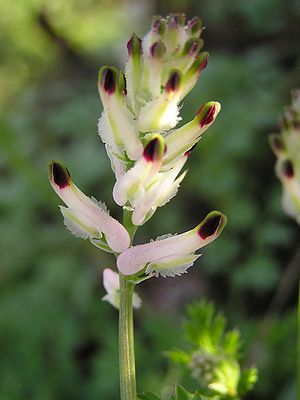Vine smoke
| Vine smoke | ||||||||||||
|---|---|---|---|---|---|---|---|---|---|---|---|---|

Inflorescence of a creeping earth smoke |
||||||||||||
| Systematics | ||||||||||||
|
||||||||||||
| Scientific name | ||||||||||||
| Fumaria capreolata | ||||||||||||
| L. |
The creeping earth smoke ( Fumaria capreolata ), also known as creeping earth smoke , climbing earth smoke or white earth smoke , is a plant from the poppy family (Papaveraceae). It is much rarer than common earth smoke . The often climbing flower stalks gave it its name.
description
Vegetative characteristics
The climbing fume is a multi-stemmed, annual , herbaceous plant that reaches heights of between 20 and 100 centimeters. The prostrate, often climbing stems have no real tendrils, but the petioles of the leaflets are sometimes creeping. In the upper area of the stems there are the blue-green alternately arranged, double pinnate leaves . The lower leaves are petiolate.
Generative characteristics
The axillary racemose inflorescence is 2 to 3.5 cm long including the inflorescence stem and contains five to 20 flowers. The hermaphrodite flower is zygomorphic . The two green, serrated, lanceolate sepals are 4 to 6 mm long. The sepals are about half the length of the petals, ignoring the spur, and they fall off easily. The four petals stand in two circles and form the zygomorphic crown, which is 9 to 14 mm long. The outer petal standing above is extended in a sack-shaped manner to form a 2 to 3 mm long spur. The three inner petals are fused at the top. The petals are white before pollination , then they turn pink and purple at the calyx opening. The flower contains two three-part stamens , one of which protrudes into the spur and there forms nectar leaves. The flowering period begins in the Mediterranean region in March, in Central Europe in May and lasts until September. Among the fruit stalks in each case a form liner sheet , which has approximately the length of the fruit peduncle.
From each flower a spherical, smooth fruit with a diameter of 2 to 3 millimeters develops, a so-called nut, which only contains one seed. The top of the fruit is trimmed and there are two rounded pits on it. The small fruits can already be seen during the flowering period. The seeds ripen from July to October.
Chromosome number
The number of chromosomes is 2n = 64 or about 70.
Distribution and ecology
The distribution area includes the Mediterranean area and Western Europe. In Central Europe this species is rare and inconsistent. In Switzerland it is on the "Red List of Endangered Species". Cultivated land, rubble sites and walls at altitudes below 1200 meters are preferred as locations. According to the ecological indicator values according to Ellenberg , the species is specified as a penumbral plant for a moderately warm to warm sea climate. The displayed soil condition is then evenly slightly moist, nitrogen-rich and moderately acidic. The creeping earth smoke thrives in Central Europe in societies of the class Chenopodietea or the association Alliarion.
The hermaphrodite flowers are usually pollinated by insects , mostly long-nosed bees.
The creeping earth smoke is spread by ants . This happens because the ants put the fruit into burrow as a source of food. After the fruit has been gnawed off, the seeds, which are worthless to the ants, are removed from the burrow and stored somewhere, where they can germinate under suitable conditions. In this way he can also get to unusual locations such as walls. This species does not develop hibernation buds and is therefore counted among the therophytes (annual plants).
Systematics
Two subspecies of the creeping fume ( Fumaria capreolata ) are generally recognized
- Fumaria capreolata subsp. babingtonii (Pugsley) PD Sell , is the UK and Ireland endemic and usually found near the coast. With a diameter of 2.5 millimeters, it has slightly larger fruits with a blunt rounded tip. The size of the flower corresponds roughly to the size of the flower stalks.
- Fumaria capreolata subsp. capreolata , with a fruit diameter of about 2 millimeters and the tip of which appears to be cut off. The flowers of this subspecies are usually shorter than the flower stalks.
Sources and further information
The article is mainly based on the following documents:
- Description in the Flora of Pakistan. (engl.)
- Ingrid and Peter Schönfelder : Kosmos was blooming on the Mediterranean , Stuttgart 2005, ISBN 3-440-10211-4
Individual evidence
- ↑ Oskar Sebald : Guide through nature. Wild plants of Central Europe. ADAC Verlag, Munich 1989, ISBN 3-87003-352-5 , p. 37.
- ↑ Fumaria capreolata at Tropicos.org. In: IPCN Chromosome Reports . Missouri Botanical Garden, St. Louis
- ^ Erich Oberdorfer : Plant-sociological excursion flora for Germany and neighboring areas . With the collaboration of Angelika Schwabe and Theo Müller. 8th, heavily revised and expanded edition. Eugen Ulmer, Stuttgart (Hohenheim) 2001, ISBN 3-8001-3131-5 , pp. 429 .
- ^ Fumaria species in "Botanical Society of the British Isles" ( Memento from October 28, 2012 in the Internet Archive ) (PDF; 426 kB)
Web links
- Vine smoke. In: FloraWeb.de.
- Vine smoke . In: BiolFlor, the database of biological-ecological characteristics of the flora of Germany.
- Profile and distribution map for Bavaria . In: Botanical Information Hub of Bavaria .
- Fumaria capreolata L. In: Info Flora , the national data and information center for Swiss flora . Retrieved October 23, 2015.
- Fumaria capreolata. Flora of NW Europe (eng.) ( Memento from February 22, 2013 in the web archive archive.today )
- Thomas Meyer: Creeping earth smoke (Fumaria capreolata). Data sheet with identification key and photos, Flora-de: Flora von Deutschland.
- Creeping duivenkervel - Fumaria capreolata. Data sheet with distribution maps, Wilde-Planten.nl (Dutch).
- Fumaria capreolata. Area map Europe, Wilde-Planten.nl ( Memento from November 7, 2007 in the web archive archive.today )
- Fumaria capreolata L. Data sheet and global area map, Global Biodiversity Information Facility .
- Galleries with images: Katholieke Universiteit Leuven , Guenther-Blaich.de .

